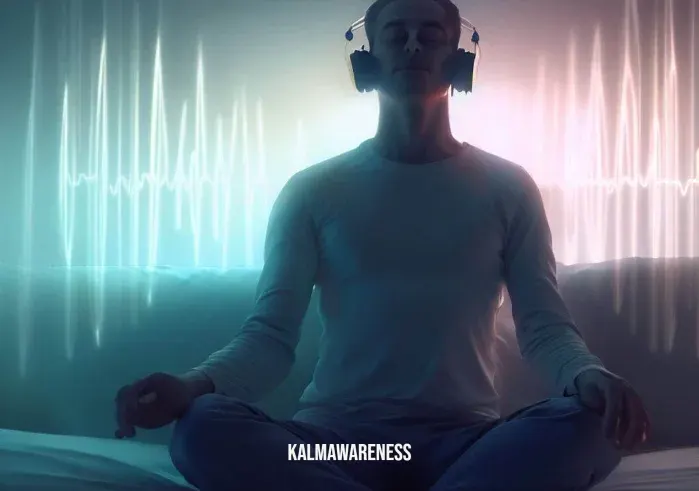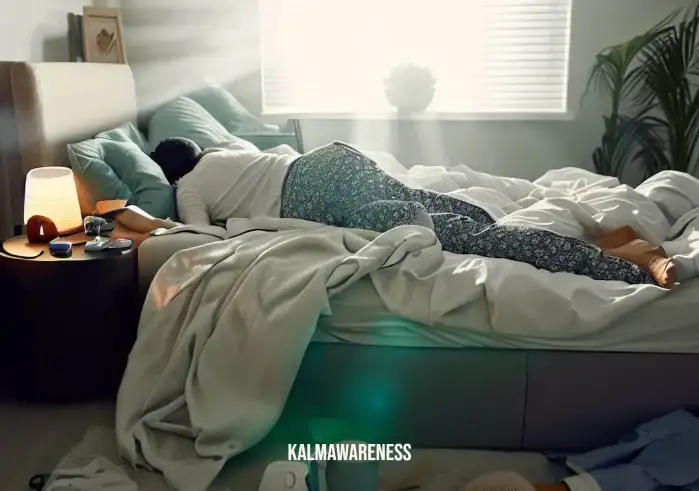Finding Harmony: The Role of Frequencies for Sleep
Whether you’re a seasoned yogi or a newbie to the world of wellness, the quest for restorative sleep remains constant. With the strains of modern life, people all over the world are turning to the realm of sound healing and relaxation to find a cure for sleep-related challenges. One such technique that’s gaining popularity is the use of frequencies for sleep.
The Science Behind Sleep and Frequencies
To fully understand the concept of frequencies for sleep, we need to take a step back and explore the basis of our existence – the human energy system. We are, after all, vibrational beings. Our bodies resonate with energy and frequencies, visible through the rhythmic beating of our hearts or the harmonious functioning of our internal organs.
Many believe that specific frequencies can stimulate certain states within our bodies. It’s where the science of binaural beats comes in, as explained in this article.
“Binaural beats are an auditory experience where the brain perceives a rhythmic beat resulting from two slightly different frequencies presented to each ear separately.”
The idea is that by listening to these frequencies, our brain can ‘sync’ with this rhythm, guiding us towards a desired state – in this case, sleep.
The Power of 888Hz, 999Hz, and Beyond
Different frequencies have different effects on our brain and body. For example, 888Hz is often associated with profound inner peace and believed to enhance the feeling of love and harmony. If you’d like to delve deeper into the mystery of 888Hz, we’ve explored this in depth in one of our articles.
On the other hand, the 999Hz frequency is thought to promote a sense of profound change and transformation. Frequencies like 1000Hz and 12622Hz also carry their unique vibrations.
When it comes to sleep, lower frequencies are often recommended. One such frequency, 8Hz, falls within the theta brainwave range, often associated with deep relaxation and sleep.
Exploring the Connection Between Chakras and Frequencies
Just as frequencies have their unique vibrations, so do our chakras or energy centers. The sound baths for different chakras resonate at different frequencies, which is what we explore in our chakra sound baths article. By aligning these frequencies, we can potentially influence our sleep patterns.
Embrace the tranquil symphony of sleep frequencies
“Listening to the right frequencies can usher in a symphony of calm, lulling you into a restful sleep.”
Can You Meditate Lying Down?
The answer is a resounding yes! Meditating doesn’t always have to be in the traditional seated position. We cover this topic extensively on our site. Whether you want to know if you can meditate lying down or if you can meditate in bed, we have the answers for you.
I invite you to continue to the next part of this enlightening journey, where we will explore more about how to utilize these frequencies, various methods of integrating them into your sleep routine, and the specific benefits they hold for sleep.

Sound Therapy: A Comprehensive Guide to Frequencies for Sleep
Sound therapy is gaining significant recognition for its role in promoting deep sleep. Leveraging different frequencies, it provides a natural solution for those suffering from sleep disorders like insomnia. Let’s take a look at how you can incorporate sound therapy into your daily routine and harness the power of frequencies for sleep.
Sound Therapy Techniques for Sleep
There are several methods of integrating sound therapy into your nightly routine. The optimal technique will depend on individual preference and receptivity to certain sounds or frequencies.
- Guided Sleep Meditations: These involve a speaker guiding you through relaxation techniques or visualizations. Our 20-minute guided sleep meditation and the deep sleep relaxation meditation are excellent starting points.
- Sleep Stories: This approach involves a soothing voice narrating a calm, engaging story, designed to help you fall asleep. Find a collection of relaxing narratives in our meditation sleep stories.
- Yoga Nidra for Sleep: Yoga Nidra, or ‘yogic sleep,’ is a guided meditation that leads you to the edge of sleep, allowing for deep relaxation. Learn more about this technique in our article on the best yoga nidra for sleep.
Specific Frequencies for Different Sleep Issues
Our bodies respond differently to various frequencies. For certain sleep issues, particular frequencies may prove more effective. Below is a table outlining some of these frequencies and their potential benefits.
| Frequency (Hz) | Related Issue | Potential Benefit |
|---|---|---|
| 13Hz | Trouble falling asleep | Promotes light relaxation before sleep |
| 853Hz | Anxiety-induced insomnia | Promotes a sense of peace and tranquility |
| 1361Hz | Frequent waking | Encourages deep, uninterrupted sleep |
| 17206Hz | Stress-related sleep issues | Encourages the release of tension and stress |
| 21042Hz | Sleep issues due to pain | Promotes the relief of pain and discomfort |
Sound Therapy and Insomnia
Sound therapy can be a potential remedy for people suffering from insomnia. For some, insomnia comes with a racing mind, and for others, it’s the result of anxiety or stress. The calming frequencies for insomnia can help quiet the mind, creating an environment conducive to sleep. We have a range of resources on our site, such as guided sleep meditation for insomnia and insightful insomnia stories.
FAQs on Frequencies for Sleep
Here, we answer some common questions regarding the use of frequencies for sleep.
1. Can I meditate while lying down?
Absolutely! Meditation can be performed in any position where you feel comfortable. For more on this, refer to our article Can You Meditate While Lying Down.
2. Can frequencies help with headache relief?
Yes. Certain frequencies are believed to help reduce the intensity of headaches, like the ones discussed in our articles on frequencies for headaches and frequency to get rid of headaches.
Stay tuned for the next part of this article, where we will delve deeper into the world of frequencies and their healing effects on sleep disorders. We will also explore real-life success stories and how frequencies have changed lives.

How Frequencies for Sleep Enhance Your Health: A Closer Look
Sound therapy, specifically through the use of frequencies for sleep, can be an invaluable tool in enhancing the quality of your rest and, consequently, your overall well-being. This chapter delves into the broader health implications of sound therapy, the science behind it, and the profound ways in which these frequencies can shape your life.
The Science Behind Frequencies for Sleep
You may be wondering, how do sound frequencies affect sleep? The answer lies in the brain’s neuroplasticity, or its ability to reorganize itself by forming new neural connections. By exposing your brain to particular frequencies, it can “tune in” to this frequency and adjust its brainwaves accordingly, a process known as brainwave entrainment. This can encourage states of deep relaxation and sleep.
Our guide on brainwave entrainment and binaural beats offers a more in-depth understanding of this process.
Healing and Restorative Effects of Sound Therapy
Sound therapy using frequencies for sleep not only encourages better rest but also promotes healing and restoration. As the renowned physicist Nikola Tesla once said, “If you want to find the secrets of the universe, think in terms of energy, frequency, and vibration.” Sound therapy leverages this universal language to instigate positive changes in your physical and mental health.
For instance, specific frequencies like 999Hz and 1000 Hz have been suggested to foster healing and wellness, respectively. Also, the use of chakra sound baths can balance your body’s energy centers, leading to improved health.
Overcoming Anxiety with Frequencies for Sleep
Anxiety is a common hindrance to good sleep. Luckily, sound therapy provides an array of frequencies that can help mitigate feelings of anxiety. As the famous composer Leonard Bernstein said, “Music can name the unnameable and communicate the unknowable.” In this case, music, or more specifically, sound frequencies, can communicate peace and tranquility to an anxious mind.
In this context, you may find our resources on frequencies for anxiety and frequency for anxiety incredibly helpful.
Frequencies for Sleep and Meditation
Combining sound therapy with meditation can enhance the benefits of both practices, promoting profound relaxation and improving sleep quality. As the Zen saying goes, “Silence is not silent. Silence speaks. It speaks most eloquently. Silence is not still. Silence leads. It leads most perfectly.”
Sound therapy provides a gentle, rhythmic background for meditation, and when combined with specific sleep-inducing frequencies, it can be a powerful tool for those struggling with sleep disorders. If you’re interested in learning more about how to integrate meditation with sound therapy, our articles on lying down and meditation and meditating in bed could be useful resources.
In the next part of our comprehensive guide, we will dive into the realm of binaural beats, isochronic tones, and other forms of sound therapy. We’ll also explore real-life stories of people who have used these techniques to transform their sleep patterns and improve their lives. Stay tuned!

Frequencies for Sleep: Binaural Beats, Isochronic Tones, and Their Impact on Your Sleep
In the pursuit of quality sleep, understanding the tools available to us is key. This chapter explores two prominent types of sound therapy: binaural beats and isochronic tones. We’ll examine their mechanisms, benefits, and how they work hand-in-hand with sleep frequencies.
Understanding Binaural Beats and Isochronic Tones
Both binaural beats and isochronic tones are forms of auditory brainwave entrainment, aiming to align your brainwave frequency with a desired state – such as relaxation or sleep.
Binaural Beats
Binaural beats work by sending two different frequencies to each ear. The brain perceives a third frequency equal to the difference between the two and synchronizes with it. This can help encourage relaxation, concentration, or sleep, depending on the frequency used.
Isochronic Tones
Isochronic tones, on the other hand, utilize a single tone that is manually spaced out, creating a rhythmic pulsating sound that can lead to profound states of relaxation and sleep.
Our insightful guide provides more in-depth knowledge on these types of sound therapy.
| Binaural Beats | Isochronic Tones | |
|---|---|---|
| Mechanism | Uses two different frequencies sent to each ear | Utilizes a single pulsating tone |
| Application | Requires headphones for best results | Can be used with or without headphones |
| Impact | Can induce states of relaxation, concentration, and sleep | Known to lead to profound states of relaxation and sleep |
How These Frequencies Enhance Your Sleep
In the words of Oprah Winfrey, “Every day brings a chance for you to draw in a breath, kick off your shoes, and dance.” In the context of sleep, each night is an opportunity to unwind, let go of the day’s worries, and surrender to the rhythms of restful sleep. Binaural beats and isochronic tones can help us seize this opportunity, fostering an environment conducive to deep, restorative sleep.
For example, the 888 Hz frequency is believed to be beneficial in promoting relaxation and deep sleep. Combining this with binaural beats or isochronic tones can heighten the sleep-inducing effects.
Real-Life Experiences with Sleep Frequencies
Many people have found hope and success in their struggle with sleep disorders through sound therapy. Our collection of sleep restriction therapy success stories offers first-hand experiences of individuals who have successfully used these techniques.
An encouraging quote by Sarah Ban Breathnach resonates with these stories, “Take a leap of faith and begin this wondrous new year by believing. Believe in yourself.” Similarly, believe in the possibility of better sleep and give these frequencies a try.
The following chapter will guide you in your journey to better sleep, introducing various tools and practices that complement frequencies for sleep. We’ll discuss how to incorporate yoga nidra, meditation practices, and mindfulness into your routine, all designed to boost the effects of sound therapy. See you in the next chapter!

Frequencies for Sleep: Exploring the Power of Yoga Nidra, Mindfulness, and Meditation
Understanding the importance of mindfulness, yoga nidra, and meditation in the context of sleep frequencies reveals a holistic approach to achieving restful sleep. The tools and techniques we’ll discuss are all tailored to complement and enhance the effects of the frequencies for sleep we’ve explored so far.
Yoga Nidra: The Sleep of the Yogis
Yoga Nidra, or ‘yogic sleep’, is an ancient practice that induces a state of deep relaxation, bridging the gap between wakefulness and sleep. Studies show that Yoga Nidra can help with insomnia, anxiety, depression, and stress. When combined with frequencies for sleep such as the soothing 136.1 Hz, it can be a powerful tool to improve the quality of your sleep.
“Sleep is the best meditation.” – Dalai Lama
This quote encapsulates the essence of Yoga Nidra, drawing a parallel between the tranquility achieved during meditation and the deep restfulness of sleep. Learn more about how Yoga Nidra can benefit your sleep in our detailed guide on the best Yoga Nidra for sleep.
Embracing Mindfulness for Better Sleep
Mindfulness involves being completely present and fully engaged in the current moment. This state of awareness can help you let go of the day’s stresses, encouraging your mind and body to relax and prepare for sleep.
Incorporating mindfulness into your bedtime routine can work in synergy with frequencies for sleep. For instance, the 999 Hz frequency, known for its calming effects, combined with mindfulness, can provide a comprehensive approach to achieving restful sleep.
The Role of Meditation in Sleep Quality
Meditation is a time-honored practice known for its relaxation and stress-relieving benefits. It’s an integral part of many sleep-enhancing methods, serving as a bridge between the conscious and unconscious mind.
One effective meditation technique for sleep is the guided sleep meditation. It uses verbal guidance to lead you into a state of deep relaxation and sleep. Our collection of 20-minute guided sleep meditations is an excellent place to start your meditation journey.
“Meditation is the tongue of the soul and the language of our spirit.” – Jeremy Taylor
This quote captures the essence of meditation, reflecting its ability to connect us to our innermost self and bring peace to our mind and body.
In the next chapter, we’ll explore how different environments and lifestyle habits can affect the efficacy of sleep frequencies. We’ll discuss the importance of sleep hygiene, share tips to create a sleep-conducive environment, and explore how different activities can either enhance or hinder the effects of sleep frequencies. Join us as we continue this journey towards better sleep.

Frequencies for Sleep: Your Environment and Habits Matter
In the preceding chapters, we’ve discussed the foundational concepts of using frequencies for sleep, along with powerful practices like Yoga Nidra, mindfulness, and meditation. As we conclude our exploration, let’s turn our attention to the environmental and lifestyle factors that can influence the effectiveness of these techniques and enhance your sleep experience.
Creating a Sleep-Conducive Environment
A sleep-friendly environment is fundamental for good sleep. As you use frequencies for sleep, make sure your surroundings support rather than hinder your relaxation.
- Soothing Sounds: Utilize the healing power of sound. Frequencies like the 1000 Hz, known for their soothing effects, can create a peaceful auditory environment conducive to sleep.
- Temperature Control: A cool room is often more conducive to sleep. Try to maintain an ideal temperature of around 18°C (65°F) in your bedroom.
- Lighting: Dim or no lights signal your brain that it’s time to sleep. Blackout curtains or eye masks can be useful.
- Comfort: Invest in a good quality mattress and pillows to ensure your body is well-supported.
Modifying Your Lifestyle Habits
Your daily activities and habits significantly impact your sleep quality. Here are some practices to consider:
- Regular Exercise: Regular physical activity can help you fall asleep faster and enjoy deeper sleep. However, try not to exercise too close to bedtime as it might interfere with your sleep.
- Healthy Diet: What you eat affects how you sleep. Limit caffeine and alcohol intake, particularly in the evening, and try to eat lighter meals at night.
- Mindful Practices: Regular meditation or mindfulness practices, like the ones described in guided meditations for deep sleep, can significantly improve your sleep quality.
Conclusion
As we conclude our exploration of frequencies for sleep, remember that achieving restful, deep sleep is a holistic process, one that involves not only the right frequencies but also your daily practices and environment. In the words of Arianna Huffington, “Sleep is a fundamental human need that must be respected.” And respect it we shall, by creating a conducive environment and adopting beneficial practices to enhance our experience of sleep.
Thank you for joining us on this enlightening journey through the world of sleep frequencies. We hope this knowledge aids you in your quest for restful slumber. Be sure to revisit our collection of articles for more insights on Deep Sleep, Relaxation, and Meditation. Sleep well, and awaken refreshed for a new day!





